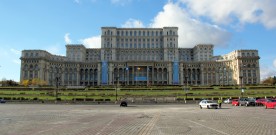While presenting my thesis paper in Bucharest, I learned that most travelers tend to breeze through the Romanian capital en route to the more celebrated destinations of the country, like Transylvania or Moldova. Despite its massively over-sized architecture and some neighborhoods which are still under renovation, I found Bucharest to have a mix of both charm and culture. Here are 10 things that made my stay in Bucharest memorable, and which hopefully help make your trip to the city more than just an overnight stop.
Palace of the Parliament
A short walk from the historic center of Bucharest is the Palace of the Parliament. Built over 10 years, from 1984-1994, the Palace sits on an area of 365,000 sq meters and is the ultimate symbol of Romania’s communist legacy. The  Palace is the second largest building in the world, behind the Pentagon, and claims are out there that it can be seen from space.
Palace is the second largest building in the world, behind the Pentagon, and claims are out there that it can be seen from space.
During its 10 year construction workers worked 24 hours per day and used only 100% Romanian materials (marble, wood, crystal and silk). This requirement was put in place as a way to symbolize the entire country’s contribution, as it was ‘constructed by Romanians from Romanian materials.’ Over 700 architects were enlisted to design and construct the building, however, all were under the direction of the 28 year old lead architect Anca Petrescu. Definitely a site not to be missed, the Palace is open daily and offers both a basic and extended tour. Tours last about 2 hours, fill up quickly and cost 25 Ron ($7.65) per person.
Arc de Truimph
Helping Bucharest live up to its nickname,’Little Paris,’ is Le Petite Arc de Triumph (The Little Arc de Triumph). Finished in 1936, the Arc has a history dating back to the 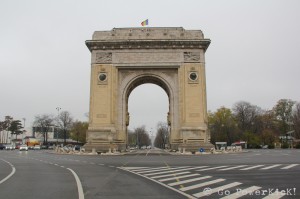 late 1900’s. Located in the northern area of the city, a short walk from the Aviatorilor metro stop, the Arc was built in a similar style to it’s bigger brother in Paris. It’s positioned in the center of a large roundabout, at the intersection of 4 large boulevards where cars, buses and people zoom past at all hours of the day.
late 1900’s. Located in the northern area of the city, a short walk from the Aviatorilor metro stop, the Arc was built in a similar style to it’s bigger brother in Paris. It’s positioned in the center of a large roundabout, at the intersection of 4 large boulevards where cars, buses and people zoom past at all hours of the day.
For those daring enough to try dodging traffic, there is a staircase inside the Arc which leads up 85 feet to the top and offers a great view of the city. If you’re visiting Bucharest in winter, try not to miss the military parade beneath the Arc which takes place on Romania’s national holiday, December 1st.
Dristor Kebab
While not traditional Romanian cuisine, the kebab (or shawarma) has been welcomed by the people of Bucharest with open arms and hungry bellies. Dristor Kebab, opened in 1999, specializes in the popular Turkish cuisine and has shops in 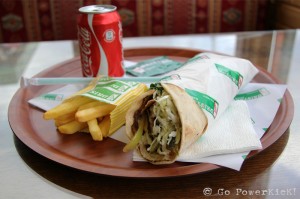 multiple locations around the city. With an extensive menu, diners have a choice of baguettes, plate lunches and the traditional shawarma wraps when ordering, which range from 16 to 23 Ron ($4.91 – $7.06).
multiple locations around the city. With an extensive menu, diners have a choice of baguettes, plate lunches and the traditional shawarma wraps when ordering, which range from 16 to 23 Ron ($4.91 – $7.06).
The real action happens at the filling station after an order has been placed. With an open pita in one hand, a pair of tongs in the other and a backdrop of massive racks of meat cooking on spits, your kebab technician will hollar at you asking what you’d like in your kebab. French fries inside is the first questions. Then, after slicing off pieces of chicken or beef to lay inside the pita, eaters are offered a choice of tomatoes, cabbage, pickles, onions, jalepanoes or cilantro. You also have a choice of sauces to be squirted on the kebab, mayonaise, katsup or spicy. Tightly wrapped, its literally bursting with flavor. A kebab from Dristor is a must try and a great snack in-between sightseeing. Your stomach will never forgive you for skipping this!
Jewish Museum
Surviving World War II, the Jewish Museum in Bucharest is a fantastic place to see the extensive history of the Jewish population in Romania. Located inside the old Templul Unirea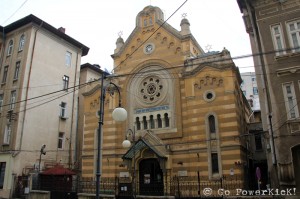 Sfântă synagogue, the museum displays geographic maps, economic and political documents, literature and art which show just how involved in Romanian society the Jewish people were prior to the onset of World War II.
Sfântă synagogue, the museum displays geographic maps, economic and political documents, literature and art which show just how involved in Romanian society the Jewish people were prior to the onset of World War II.
Entry to the museum is free and a short guided tour through the artifacts is provided by a museum docent. The temple also has a small holocaust memorial dedicated to the 300,000 Romanian Jews who were killed. The Jewish Museum is a short distance from another temple/museum as well, called ‘the great synagogue,’ which has a larger holocaust memorial inside. The museum is open every day except Saturday’s and located a short walk from the Piata Unirii metro stop.
Lipscani District
Dating back to the middle ages, the Lipscani District is home to some of the earliest settled areas in Bucharest; with churches and other buildings which have histories dating back to the 15th and 16th centuries. During the 1980’s the district thankfully escaped Ceaușescu’s demolition plan to pave the way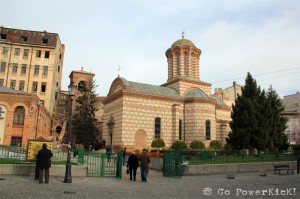 for a grandiose Socialist capital. Afterward, the area became neglected and subsequently transformed into a slum district where many of the poor Roma population lived.
for a grandiose Socialist capital. Afterward, the area became neglected and subsequently transformed into a slum district where many of the poor Roma population lived.
10 years of renovation have since given Lipscani a ‘face lift,’ and turned it into the heartbeat of downtown Bucharest. Coexisting amongst antique shops, upscale clothiers, restaurants, bars and night clubs; it’s cobblestone streets and Gothic architecture help keep its scrappy and gritty past alive. The narrow streets are great for walking and there are plenty of other sights in the neighborhood to see such as the National History Museum, The CEC Palace, The Stavropoleos and Curtea Veche Churhes and Manuc’s Inn. When the weather is warm, Lipscani is the perfect place to sit outside at a cafe and enjoy a drink or something to eat.
Caru’ cu Bere
For the ultimate experience in traditional Romanian cuisine, a trip to Caru’ cu Bere is a must. Opened in 1888, on Strada Stavropoleos in Old Town, it is one of the oldest beerhouses in Bucharest. The restaurant’s name means ‘Cart with Beer’ and back in the day when a beer was ordered it was served straight from a barrel in a special mug for each patron. Built in Gothic-style architecture the restaurant is outfitted with 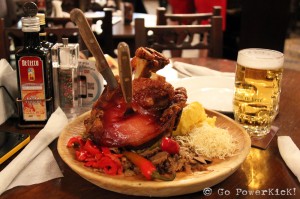 stained-glass windows, spiral staircases, ornate woodwork and a very formal style of service from an impeccably dressed waitstaff.
stained-glass windows, spiral staircases, ornate woodwork and a very formal style of service from an impeccably dressed waitstaff.
The menu at Caru’ cu Bere is the size of a newspaper and loaded with traditional Romanian staples. Choosing what to order can be difficult with tasty dishes like ciorba soups, sarmale, mutton stew and Romanian carp on the menu. For diners who want the real deal, the house specialty is a dinner you’ll never forget. For 75 Ron, ($23.03), a Romanian pork shank is delivered to your table complete with fork and knife protruding and served with horseradish, sauerkraut and a chili pepper. The authenticity and deliciousness of Caru’ cu Bere are unparalleled and off the charts.
Village Museum
Created in 1936, the village museum in Bucharest is a fantastic step into Romania’s past and a welcome break from the ‘bigger is better’ architecture in the city. Located on Herăstrău lake, the museum is both the biggest an the oldest outdoor 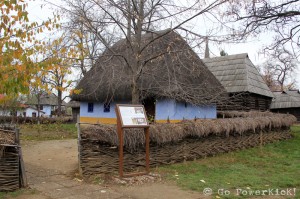 museum in Europe. For a small entry fee of 10 Ron ($3.07), visitors can see the vastly different styles used to build homes in the provinces of Romania.
museum in Europe. For a small entry fee of 10 Ron ($3.07), visitors can see the vastly different styles used to build homes in the provinces of Romania.
Inside the museum, 85 different styles of homes from Transylvania, Banat, Muntenia, Oltenia, Dobrogea and Maldova take visitors on a walking tour through the country’s folk and peasant history. Varying in style from small farms to homes half buried in the ground, it’s interesting to see just how people lived outside the big city. In front of each home is plaque detailing exactly where in Romania each style comes from as well as some basic information on how it was built and what daily life was like for the home dwellers. The museum is open on Monday from 9am to 5pm and Tuesday to Sunday from 9am to 7pm. They also have a souvenir shop and vendors outside selling traditional Romanian sweets and cakes, which are delicious.
Romanian Athenaeum
Called ‘The Heart of Romanian Culture,’ the Anthenaeum is an impressive concert hall located in the center of Bucharest. Built in 1888, it has been the venue for concerts,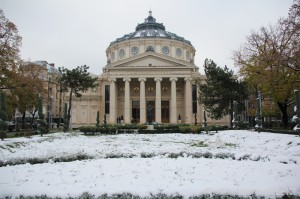 famed scientists giving lectures and also where orchestras and musicians have launched their careers. Today, it houses the Philharmonic and is the venue for the annual George Enescu international music festival.
famed scientists giving lectures and also where orchestras and musicians have launched their careers. Today, it houses the Philharmonic and is the venue for the annual George Enescu international music festival.
An interesting fact about the Anthenaeum is that during its construction the original financiers ran out of money. Learning of the possibility that construction might not be completed, Constantin Esarcu who was a natural scientist, made a plea to the people of Romania to “Give one penny for the Anthenaeum.” His plea was successful and the money necessary to complete the Anthenaeum was raised. Resembling an ancient Greek temple, the Anthenaeum has a high domed roof and is lined inside with marble and columns. If you are a patron of the arts, then experiencing a show first hand inside this symbol of Romania and listening the the perfection of the music is certainly in order!
Eat a pretzel
The pretzel, or ‘covrigi,’ has integrated itself into every day life becoming a popular snack for Romanians living in Bucharest. Some say pretzels were first introduced 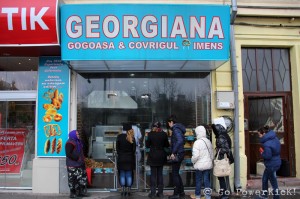 around 1800 in the southwestern city of Buzău by the Greeks who wanted to help increase wine consumption, however, connoisseurs argue that today’s covrigi are quite similar to German pretzels. Either way, pretzel making has been perfected in Bucharest.
around 1800 in the southwestern city of Buzău by the Greeks who wanted to help increase wine consumption, however, connoisseurs argue that today’s covrigi are quite similar to German pretzels. Either way, pretzel making has been perfected in Bucharest.
At most shops pretzels range from 1 to 3.5 Ron ($0.30 – $1.07) depending on the toppings. They can come sprinkled with poppy seeds, sesame seeds or salt, and some even come stuffed with cheese and olives or a hotdog and cheese. At any time of day, all over Bucharest, you can find crowds queued in front of small storefronts to get their daily covrigi dose. At a time when the likes of McDonald’s and KFC are taking over cityscapes, it’s nice to see a more traditional snack remaining a fast food institution. A warm pretzel makes a great snack while sightseeing and of course goes rather well with a beer.
Day trip to Dracula’s Castle
While not directly in the city, a trip to Bucharest wouldn’t be complete without a day trip to see Dracula’s castle (Bran Castle). Getting to the castle, roughly 175 km from Bucharest near the city of Brasov, is quite easy. Trains from the Bucharest North train station to Brasov run frequently and are relatively inexpensive, 100 Ron ($30.79) round trip. The castle 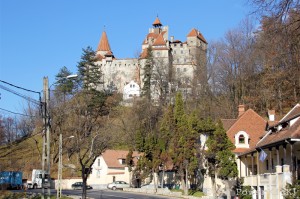 sits on the border between Transylvania and Wallachia and can be reached by hiring a taxi upon arrival in Barsov.
sits on the border between Transylvania and Wallachia and can be reached by hiring a taxi upon arrival in Barsov.
Walking up to the castle is a bit of a show with hoards of vendor stalls selling all types of Dracula merchandise, from t-shirts and paintings to shot glasses. If you’re lucky you might see a masked Dracula walking around frightening visitors. Entry into the castle is 20 Ron ($6.15) and is a self guided tour. Inside, the castle’s narrow hallways, low ceilings and nice views give it more of a homey feel than a spooky vampire’s layer. Placards inside share the history of the castle, which dates back to the 1400’s as a guard of the strategic Bran pass against the invading Turks. There is also information inside about Vlad the Impaler (the character behind Bram Stoker’s Dracula), how he got his name and coincidentally how he didn’t actually reside at Dracula’s Castle.
Comments
More Good Reads!

The Best Mai Tai In The World
May 23, 2014
Helicopter Over Oahu
May 10, 2014
May 2014 PowerKicK Of The Month
May 01, 2014
Bike The Golden Gate Bridge
April 29, 2014
Hua Hin Hills Vineyard
April 19, 2014
Songkran in Nan
April 10, 2014
April 2014 PowerKicK Of The Month
April 01, 2014
Mae Hong Son Motorcycle Loop: Mae Sot to Mae Hong Son
March 28, 2014
Becoming A Buddhist Monk In Thailand
March 20, 2014






